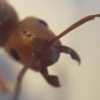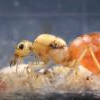Queen 1 - laid eggs as of 7-15-19 - Zeiss took a stab at this one in chat.
1. Location (on a map) of collection: Prescott, AZ
2. Date of collection: 7-11-19
3. Habitat of collection: Scrub Oak
4. Length (from head to gaster): 12-13mm
5. Color, hue, pattern and texture: Black appears semi shiny smooth
6. Distinguishing characteristics:
7. Distinguishing behavior:
8. Nest description: N/A
9. Nuptial flight time and date: Unknown. Found around 8-9pm on top of door in the home.
Queen 2
1. Location (on a map) of collection: Prescott, AZ
2. Date of collection: 7-13-19
3. Habitat of collection: Scrub Oak
4. Length (from head to gaster): 5 mm
5. Color, hue, pattern and texture: Black appears semi shiny
6. Distinguishing characteristics: Small – assumed to be “pavement ant” queen
7. Distinguishing behavior: Wingless on collection
8. Nest description: N/A
9. Nuptial flight time and date: Guessing in the morning. There were many pavement ants strangely gathered outside but I observed no winged ants. I found this queen 1-2 hours after that.


Queen 3 - Best shot of all of the queens featured. Don't know how I pulled that off.
1. Location (on a map) of collection: Prescott, AZ
2. Date of collection: 7-14-19
3. Habitat of collection: Scrub Oak
4. Length (from head to gaster): 11 or 12mm
5. Color, hue, pattern and texture: Biocolor. Looks red or orange. Black gaster. appears semi shiny
6. Distinguishing characteristics:
7. Distinguishing behavior: Seemed rather quick. 2 were observed in the same dirt patch appearing to be pushing each other around when they came close to each other.
8. Nest description: N/A
9. Nuptial flight time and date: Assumed to be about 9am. I was in the drive through at starbucks and they were falling on my truck while I waited.
Queen 4 - Zeiss took a stab at this one in chat.
1. Location (on a map) of collection: Prescott, AZ
2. Date of collection: 7-14-19
3. Habitat of collection: Scrub Oak
4. Length (from head to gaster): 12mm
5. Color, hue, pattern and texture: Orangish. Appears semi shiny to shiny and smooth
6. Distinguishing characteristics:
7. Distinguishing behavior: Seemed rather quick. 2 were observed in the same dirt patch appearing to be pushing each other around when they came close to each other.
8. Nest description: N/A
9. Nuptial flight time and date: Assumed to be about 9am. I was in the drive through at starbucks and they were falling on my truck while I waited.
Edited by Dukagora, July 17 2019 - 5:38 PM.






























